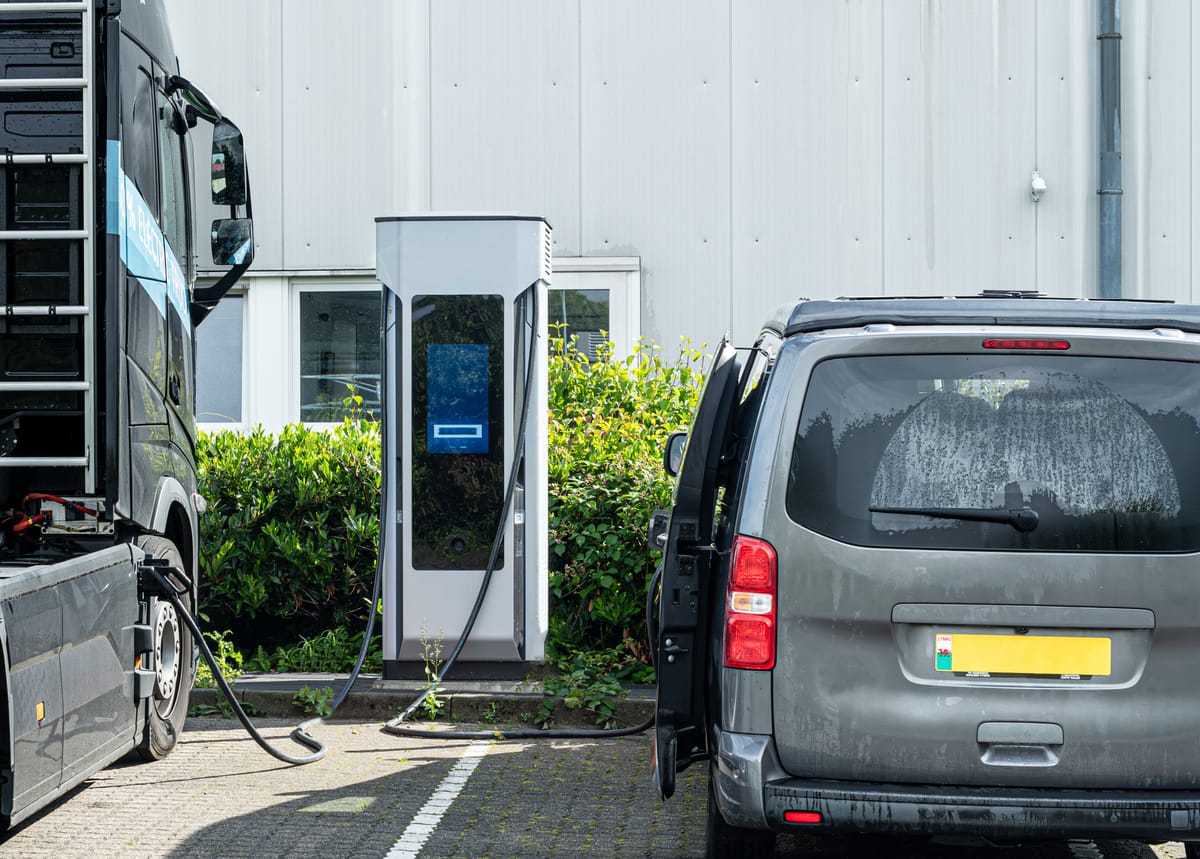Trucking wins as Trump halts Calif. EV rules
Plus: DOT eyes enforcement overhaul | ICE compliance tips for fleets

Immigration enforcement is top of the news, but should trucking companies be concerned? We spoke with an immigration attorney about how businesses can prepare.
Meanwhile, Trump signs a handful of resolutions to reverse approval for California's emissions policies, and the DOT considers enforcement changes.
Plus, posting on your fleet's LinkedIn page or blog isn't just for views and clicks. It might help you win more business.

How trucking companies can prepare for ICE enforcement
Immigration enforcement is once again in the spotlight—and trucking companies should take note. With ICE targeting labor-heavy industries under the Trump administration’s directive, now is the time to revisit compliance processes, especially when it comes to employment verification and I-9 protocols.
Attorney Scott Malyk has spent more than two decades advising companies on immigration law and compliance. As a senior partner at Meyner and Landis LLP, he’s helped employers understand what enforcement actions may look like—and how to prepare. We asked him to outline practical steps trucking businesses can take to minimize legal exposure and stay compliant. - Emily Kelchen
President Trump campaigned on overhauling our nation’s immigration laws, and we are now seeing that play out. Were most of the businesses you work with prepared for this shift?
No. It’s created a lot of uncertainty and really disrupted a lot of businesses, including those in the trucking industry. Historically, I-9 compliance was widely ignored by small and middle-market companies. Or for some businesses, perhaps their hiring needs outweighed concerns about potential fines. Now everyone is paying attention, and immigration attorneys like me are urging our clients to take steps to protect themselves and their employees.
What does that look like?
As the old saying goes, "the best defense is a good offense.” That is, the most effective way to protect yourself, your business, and your employees is to be proactive rather than passively waiting for ICE to come knocking at your door:
- Maintain organized employment records and documentation systems.
- Retain qualified counsel who specialize in immigration compliance to conduct a self-audit of your I-9 forms and train your onboarding staff on how to comply with the regulations going forward.
- Enroll in E-Verify if your business is not already enrolled.
- Research different software programs—some specific to the trucking industry—that assist you with the proper onboarding of employees, many of which offer an “audit trail” that is easily printed and turned over to ICE in the event of NOI issues. But beware, not all such programs get you to 100% compliance, so these programs should be vetted by counsel.
- Designate a response team to an ICE intervention.
What do you mean by response team?
This is fairly straightforward—choose a point person for each location (with a backup) to handle any interaction with ICE (e.g. HR director, compliance officer, legal counsel). The response team should:
- know who to contact immediately in the event of an ICE visit (business owners, counsel, human resources) and do so;
- ask the ICE agents to identify themselves and provide their credentials;
- request a copy of any documents the ICE agents brought with them; and
- be familiar with how to verify warrants and respond to such warrants as required by law.
If the ICE representatives are there to serve an NOI, under no circumstances should the response team waive the 3-business day window provided in the NOI to produce documents, unless legally required. Use this time to work with counsel to review and prepare documents for turnover to ICE.
What are some signs that a business might be on ICE’s radar?
ICE does not forecast its strategies to the public—these are largely covert operations. That being said, ICE has limited resources, so historically, it tends to target businesses in labor intensive industries for which the agency is confident will have the highest concentration of unauthorized workers.

Brand marketing is for trucking companies, too
Trucking is a competitive industry, and many fleets rely on traditional relationship-building methods like referrals and networking to grow their business. That's certainly a key part of marketing. But today, so is having an online presence, writes Phillip Atwood, founder of Vessel, a boutique marketing agency that caters to industries ranging from manufacturing to nonprofits and trucking companies.
Atwood shares some techniques trucking managers can use to boost their online and social media presence authentically. The goal throughout it all: "Ultimately, you want a customer to feel like you’re a trusted colleague."
Why this matters: Potential clients and customers may look to websites and social media for carrier recommendations, instead of relying on word-of-mouth or an RFP. In a crowded market, having a brand presence can help win over some business.
Get more details at Overdrive.

TEPID OUTLOOK: Analysts expect volatile spot market due to tariffs
SEVERE CRASH: Truck catches fire, falls off interstate ramp
SOONER OR LATER: Freight leaders expect driverless trucks by 2050
HAPPY BDAY: Schneider hits milestone of 90 years in operation

"One of the things that's making it hard for fleets to make decisions right now is the fact that the tariffs could come back and could increase significantly, and the question is, who's going to pay for that?"-Tim Denoyer, vice president and senior analyst at ACT Research
Aside from tariffs potentially denting volumes for fleets to haul, the import taxes could also make tractor and trailer purchases more expensive. Denoyer talks about economic uncertainty and how to navigate the trucking market. Listen to the podcast here.

Trucking groups praise Trump nixing of Calif. emissions rules
The Owner-Operator Independent Drivers Association, the American Trucking Associations and additional trucking groups applauded President Trump's move to sign a handful of joint resolutions, clawing back approval for California's emissions policies. One resolution reverses Biden's approval of the state's Advanced Clean Trucks rule, which required 75% of Class 8 truck sales to be zero-emission by 2035. Another blocked California's low-nitrogen oxide emissions rule.
Why this matters: ATA and OOIDA have called for what they say are more realistic standards to help trucking transition to lower emissions, noting that EV costs are prohibitive and charging infrastructure isn't expansive enough. Fleets operating in California won't be under mandates to purchase EVs, but they may have to forge their own path if they want to adopt electric trucks. (Trucking Dive)
DOT mulls pushing enforcement out of agencies, into courts
A new notice from the Department of Transportation proposes a potential shift in enforcement by its subagencies, including the Federal Motor Carrier Safety Administration. The notice states that enforcement actions "must be initiated in court by attorneys of the Department of Justice acting in coordination with DOT counsel.” In other words, enforcement would primarily lie in the hands of courts and judges rather than the FMCSA.
Why this matters: Safety advocates worry that the change, if approved, would result in lower enforcement standards and riskier carriers. Courts may not be as familiar with the nuances of trucking as FMCSA leaders. As the name indicates, FMCSA's purpose is to ensure safe practices among motor carriers, and this proposed change could derail those efforts. (FreightWaves)
JB Hunt, Schneider view visa enforcement as key to supply-demand balance
Executives from J.B. Hunt and Schneider said they would welcome greater enforcement of rules around B-1 visas, which let foreign drivers drop off or pick up goods in the U.S. The execs' take: fleets that skirt the rules and hire foreign drivers for domestic routes are contributing to excess supply and low rates in the freight market. The Schneider exec suggested that even a threat of more enforcement could help tighten capacity.
Why this matters: Supply has far exceeded demand in trucking for more than two years, and abusing B-1 visa requirements only adds more capacity to a market in need of the opposite. It's in the trucking industry's collective best interest to find ways to bring the broader market into equilibrium so that rates can start to rise. (Fleet Owner)

Bill connecting veterans to trucking jobs passes House committee
The House Transportation and Infrastructure Committee advanced nearly a dozen bills, including the TRANSPORT Jobs Act, which aims to create a pathway for military vets to transition to supply chain jobs. If passed, the legislation would address some of the barriers veterans face when looking for employment, as well as the challenges employers have in hiring.
Why this matters: Fleet executives often call out recruitment and retention as some of their biggest challenges. If a bill could help encourage veterans' transition into logistics fields, it could ease workforce woes and give vets meaningful careers in supply chain. (Land Line)

Thanks for reading today's edition! You can reach the newsletter team at editor@theinsidelane.co. We enjoy hearing from you.
Interested in advertising? Email us at newslettersales@mvfglobal.com
The Inside Lane is curated and written by Shefali Kapadia and edited by Bianca Prieto.





Comments ()